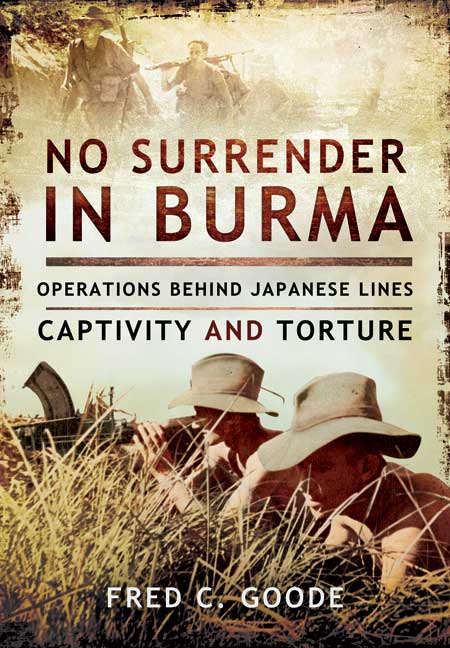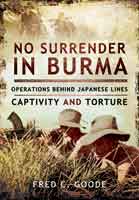No Surrender in Burma (ePub)
Operations Behind Japanese Lines, Captivity and Torture
Imprint: Pen & Sword Military
File Size: 19.2 MB (.epub)
ISBN: 9781473840966
Published: 8th October 2014
| Other formats available - Buy the Hardback and get the eBook for free! | Price |
|---|---|
| No Surrender in Burma Hardback Add to Basket | £25.00 |
This is the extraordinary true story of a British Commando in Burma who, cut off behind enemy lines, walked 2,000 miles towards India and freedom in 1942, but was betrayed to the invading Japanese only 20 miles short of his destination, tortured by the infamous Kempeitai and finally incarcerated as a POW in Rangoon's notorious Central Jail for the rest of the war.
Lance Corporal Fred Goode was one of 50 men of Special Service Detachment II (Middle East), whose role in 1941 was to support Chiang Kai-shek's forces fighting in Japanese-occupied China and to train Chinese guerrilla units in demolition and resistance. With Japan's entry into WW2 in December that year, they were tasked with destroying airfields and taking bullion to India. When they were overtaken by enemy forces before crossing the Irrawaddy River, their CO instructed them to split into four groups and head for India or Yunnan. Of the original 50 men, only Fred and seven others survived.
While not an educated man, Fred tells his extraordinary story of endurance and survival with brutal honesty. His account makes for compelling reading.
I have recently finished reading 'No Surrender in Burma' and what a fantastic book it really is.
Commando Veterans.org
It is the story of Lance Corporal Fred Goode, formerly of the Duke of Cornwall's Light Infantry and describes his involvement in SSD2, a lesser known Special Forces Operation in 1942. SSD2 was a precursor to and certainly an influence for the Chindit type operations that followed.
The book takes Fred's story from the SSD2 operation into the Thai border to check on the Japanese advance and disrupt their positions in that area, through his epic march out towards the Yunnan Provinces of China and his eventual capture by the Japanese at a place called Sadon.
Fred survived his time as a POW in Rangoon Jail and was repatriated soon after the Allies had re-taken the city in 1945.
This testimony was written by a man with a steely determination to survive and the self-confidence to ensure he succeeded.
Fred Goode was a member of a Special Forces Unit, Special Service Detachment II, whose role in 1941 was to support Chiang Kai-Shek’s Chinese Army fighting the Japanese in China. Their role was to teach weapon training, demolitions and guerrilla tactics to the Chinese soldiers. However the Japanese advance into Burma resulted in a change of role, and the force moved into Burma tasked with destroying airfields and military bases to deny them to the Japanese. However, thwarted by the speed of the Japanese advance, Goode’s force were cut off before they reached the river Irrawaddy. They split up into four smaller groups and made for either Yunan in China or India. After negotiating some 2000 miles of inhospitable jungle and only 20 miles from India Goode was betrayed to the Japanese. He was tortured and then locked up in Rangoon’s infamous Central Jail until the end of the war. This is a story of endurance and survival against the odds. Of the fifty men in Goode’s unit only eight survived the war.
WW2 Escape Lines Website
This is the extraordinary true story of a British Commando in Burma who, cut off behind enemy lines, walked 2,000 miles towards India and freedom in 1942, but was betrayed to the invading Japanese only 20 miles short of his destination, tortured by the infamous Kempeitai and finally incarcerated as a POW in Rangoon's notorious Central Jail for the rest of the war. Lance Corporal Fred Goode was one of 50 men of Special Service Detachment II (Middle East), whose role in 1941 was to support Chiang Kai-shek's forces fighting in Japanese-occupied China and to train Chinese guerrilla units in demolition and resistance. With Japan's entry into WW2 in December that year, they were tasked with destroying airfields and taking bullion to India. When they were overtaken by enemy forces before crossing the Irrawaddy River, their CO instructed them to split into four groups and head for India or Yunnan. Of the original 50 men, only Fred and seven others survived. While not an educated man, Fred tells his extraordinary story of endurance and survival with brutal honesty. His account makes for compelling reading.
Bol.com
As Feature on....
The Army Rumour Service Website
This is an account of an almost unknown aspect of WW2. The raid into Thailand ( allies of the Japanese), and the attack on the Thai Army in Thailand by a British Army commando unit, Special Service Detachment II (SSD II). Written by a young regular n.c.o., who subsequently retreated towards India, via China, with SSD II. Most of his unit were killed by Japanese or jungle. He survived only to be betrayed to the Japanese, captured and imprisoned in the notorious Rangoon Central Jail. In the course of their attempt to reach India SSD II were also trying to take a large quantity of currency and bullion to India, which they had to bury en route.
Amazon Customer 5* Review Mr Rawlinson
Told with clarity, keen observation of human frailty and moving detail and honesty.
I have recently finished reading 'No Surrender in Burma' and what a fantastic book it really is.
Amazon 5* Customer Review - S J Fogden
It is the story of Lance Corporal Fred Goode, formerly of the Duke of Cornwall's Light Infantry and describes his involvement in SSD2, a lesser known Special Forces Operation in 1942. SSD2 was a precursor to and certainly an influence for the Chindit type operations that followed.
The book takes Fred's story from the SSD2 operation into the Thai border to check on the Japanese advance and disrupt their positions in that area, through his epic march out towards the Yunnan Provinces of China and his eventual capture by the Japanese at a place called Sadon.
Fred survived his time as a POW in Rangoon Jail and was repatriated soon after the Allies had re-taken the city in 1945.
This testimony was written by a man with a steely determination to survive and the self-confidence to ensure he succeeded.
This is a remarkable story of one man's heroic struggle for survival against all odds - torture, incarceration, sickness and despair. Fred Goode, a soldier in the "Forgotten Army in Burma, and operating behind enemy lines, is overtaken by enemy forces, and forced to walk hundreds of miles, mainly through inhospitable jungle in the hope of reaching India and freedom. Fred's strength and determination throughout this terrible journey, and his subsequent capture and prolonged torture at the hands of the Japanese stand out vividly in this dramatic account of his ordeal. It is an amazing story of man's inhumanity to man, and one soldier's determination and ability to rise above the horrors of war. One of many books written about the 14th army in Burma and the inhuman treatment of allied POW's by the Japanese,"No Surrender in Burma must rank as one of the most memorable.
Amazon 5* Customer Review - Hannie Turner
This was an epic tale of human endurance, adapting and overcoming and even redemption. Mr Goode was without a doubt a 5 star human being.
Goodreads - Chuck Dooley
I have recently finished reading 'No Surrender in Burma' and what a fantastic book it really is.
COFEPOW (Children of Far East Prisoners of War)
It is the story of Lance Corporal Fred Goode, formerly of the Duke of Cornwall's Light Infantry and describes his involvement in SSD2, a lesser known Special Forces Operation in 1942. SSD2 was a precursor to and certainly an influence for the Chindit type operations that followed.
The book takes Fred's story from the SSD2 operation into the Thai border to check on the Japanese advance and disrupt their positions in that area, through his epic march out towards the Yunnan Provinces of China and his eventual capture by the Japanese at a place called Sadon.
Fred survived his time as a POW in Rangoon Jail and was repatriated soon after the Allies had re-taken the city in 1945. This testimony was written by a man with a steely determination to survive and the self-confidence to ensure he succeeded.
His account makes for compelling reading.
This is a very graphic account of endurance and survival against brutal odds. The story may be difficult to read in parts but that level of brutal treatment usually is. A story that had to be told and deserves to be read.
Firetrench















